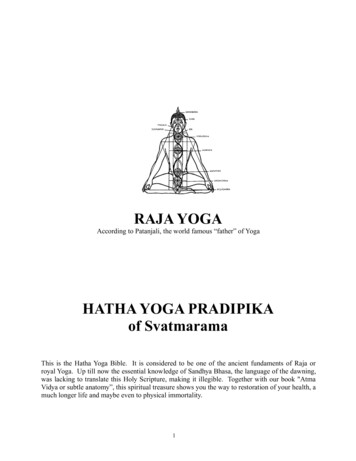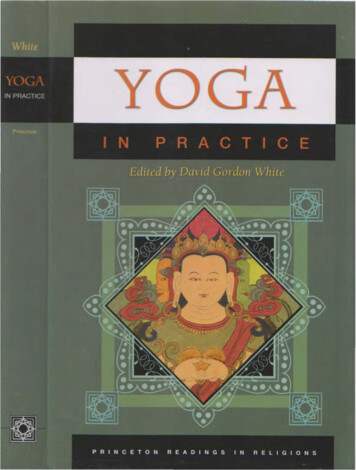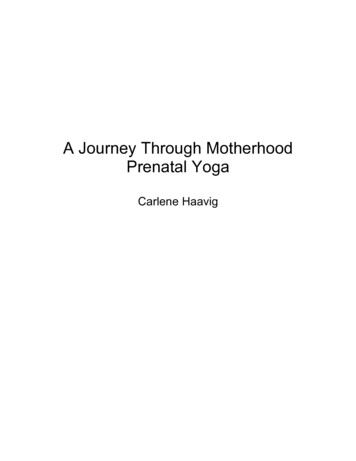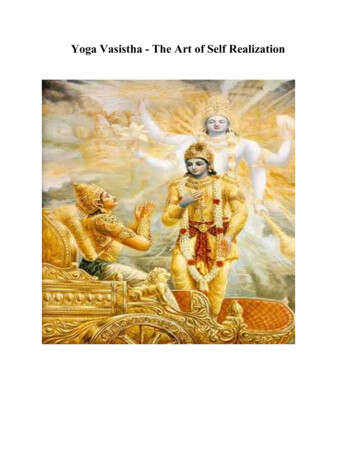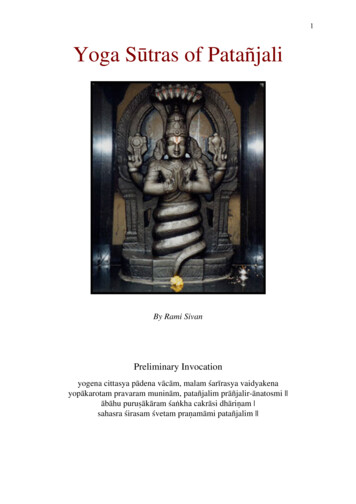
Transcription
1Yoga Sūtras of PatañjaliBy Rami SivanPreliminary Invocationyogena cittasya pādena vācām, malam śarīrasya vaidyakenayopākarotam pravaram muninām, patañjalim prāñjalir-ānatosmi ābāhu puruṣākāram śaṅkha cakrāsi dhāriṇam sahasra śirasam śvetam praṇamāmi patañjalim
2Chapter 1Samādhi Pādaḥ1:1 athā yoga anuśāsanam atha now; yoga the union; anuśāsanam expositionNow commences the [conclusive] exposition of Yoga1:2 yogaś citta vṛtti nirodhaḥ yogaḥ Yoga;; citta consciousness (cit to be bright); vṛtti fluctuations (vṛt towhirl); nirodhaḥ restraint (rudh to restrict)Yoga (is defined) as the restraint of the fluctuations of the consciousness.1:3 tadā draṣṭuḥ sva-rūpe’vasthānam tadā then; draṣṭṛ perceiver; sva-rūpe in own form (or essence); avasthānam abidingThe perceiver then abides in it's own very nature.1:4 vṛtti sārūpyam itaratra vṛtti fluctuations; sārūpyam conformity; itaratra otherwise, at other timesOtherwise he identifies with those fluctuations of mind.1:5 vṛttayaḥ pañcatayaḥ kliṣṭa-akliṣṭāḥ vṛttayaḥ fluctuation; pañcatayaḥ fivefold; kliṣṭa afflicted; akliṣṭāḥ non-afflictedThe fluctuations are fivefold both painful and non-painful.1:6 pramāṇa viparyaya vikalpa nidrā smṛtayaḥ pramāṇa valid cognition; viparyaya misconception; vikalpa conceptualisation,fancy, imagination; nidrā sleep; smṛtayaḥ recollection, memory[These five are — ] valid cognition, misconception, imagination, sleep and memory.Fluctuation and transformation are the quintessential features of Nature and the consciousness reflectsthis overall general flux. One cannot control Nature but one can control one's thinking to som extentand this is the objective of Yoga.1:7 pratyakṣa anumāna āgamāḥ pramāṇāni pratyakṣa perception; anumāna inference; āgamāḥ trustworthy testimony;
3pramāṇāni sources of valid cognitionValid cognition is achieved through direct sense-perception, inference and trustworthytestimony.Valid cognition (pramā)1. reveals the thing as it really is.2. it must be useful — have a practical application.The process of cognition1. pramatru — cognizer, the subject2. prameya — the object of cognition3. pramāna — the instrument of cognition4. pramā — cognition5. pramānya — the validity of the cognition.1:8 viparyayo mithyā-jñānam atad rūpa pratiṣṭham viparyaya misconception; mithyā false, erroneous; jñānam knowledge; atad notthat; rūpa form, appearance; pratiṣṭham based on.Misconception is false knowledge based on deceptive appearances of that [object].1:9 śabda jñāna-anupātī vastu-śūnyo vikalpaḥ śabda verbal; jñāna knowledge; anupātin following [pat to fall]; vastu object[vas to remain]; śūnya void, without [śvi to swell]; vikalpa conceptualisation,imagination.Imagination [or verbal delusion] arises when words do not correspond to reality.Vikalpa — Imagination or Conceptualisation ranges from day-dreaming to abstract thinking andincludes all forms of fantasy as seen in movies. In the absence of sense-data the mind continues toform concepts.1:10 abhāva pratyaya-ālambanā vṛttir-nidrā abhāva absence; pratyaya presented ideas, cognition; ālambanā foundation[lamb to rest upon]; vṛttiḥ fluctuation; nidrā sleep.Sleep is a process based upon the absence of cognition.1:11 anubhūta viṣaya asampramoṣaḥ smṛtiḥ anubhūta experienced; viṣaya object; asampramoṣaḥ non-robbed of; smṛtiḥ remembrance.Remembrance is the non-forgetting of something previously experienced.1:12 abhyāsa vairāgyābhyām tan nirodhaḥ abhyāsa sustained practice; vairāgya dispassion; tan they; nirodhaḥ are quelled.Through sustained practice and the cultivation of dispassion these fluctuations of mind can bestilled.
4Dispassion or vairāgya is a gradual letting go of all those things which cause us unhappiness andretard our progress. It is not so much as a forced effect but rather a result of practice.1:13 tatra sthitau yatno’bhyāsaḥ tatra therein; sthitau steadiness; yatna exertion; abhyāsaḥ is sustained practice.Sustained practice means applied effort to achieve steadiness therein.1:14 sa tu dīrgha kāla nairantarya satkāra-āsevito dṛḍha-bhūmiḥ sa it, this; tu but; dīrgha long; kāla time; nairantarya continuance,uninterruptedly; satkāra properly; āsevita cultivated/enjoyed; dṛḍha firmly;bhūmiḥ earth, grounded.But this practice is firmly grounded only after it has been cultivated properly for a long timewithout interruption.1:15 dṛṣṭa-ānuśravika-viṣaya vitṛṣṇasya vaśīkāra saṃjñā vairāgyam dṛṣṭa seen; ānuśravika reported; viṣaya objects; vi-tṛṣṇasya non-craving;vaśīkāra empowering; saṃjñā understanding; vairāgyam dispassion.Dispassion is the sense of control (self-mastery) gained from non-craving for worldlypleasures (that are seen) and for heavenly rewards (that have been heard about).1:16 tat paraṃ puruṣa-khyāter-guṇa-vaitṛṣṇyam tat that, this; paraṃ supreme; puruṣa Self; khyāter vision; guṇa primaryconstituents of nature; vai-tṛṣṇyam non-craving.The highest form of dispassion is indifference to the primary-constituents-of-nature resultingfrom a vision of the Self.Vision-of-the-Self means the establishment of awareness in pure consciousness. Once this vision ofthe true Self is obtained then one naturally becomes indifferent to any manifestation of Nature arisingfrom the Guṇas of Prakṛti.The Gunas – or Primary Constituents of ilitywisdomaltruism
5Two types of Samādhi1:17 vitarka vicāra ānanda asmitā rūpa anugamāt saṃprajñātaḥ1 vitarka cogitation/examination [tark - to argue]; vicāra reflection [car - to move];ānanda joy; asmitā “I-am-ness”; rūpa form; anugamāt connected/follows;saṃprajñātaḥ cognitive.The cognitive [spiritual absorption — samādhi, arising from concentration] is connected withfour stages:— examination, discrimination, joyful peace and simple awareness ofindividuality.The process of meditation is the involution of the creative process, from gross matter to everincreasing levels of subtlety. Firstly an examination of the external world and one's gross physicalcomponent, then in discrimination working with the mind, abiding in inner joyful peace and then at thedeepest levels an unclouded awareness of one's essential nature of Being, Consciousness and Bliss.1:18 virāma-pratyaya-abhyāsa-pūrvaḥ saṃskāra śeṣo’nyaḥ virāma cessation; pratyaya presented ideas; abhyāsa practice; pūrvaḥ former;saṃskāra subliminal activator; śeṣa residue; anyaḥ the other.The other type [of absorption/ mystical enstasy] being preceded by sustained practice resultsin the obliteration of the subliminal activators (saṁskāras).The practice which results in the attainment of the highest form of dispassion mentioned in 1:16culminates in asaṃprajñātaḥ samādhi in which state all the samskāras are wiped out.Asaṃprajñātaḥ means the transcendence of all forms of supra-cognition (prajña).1:19 bhava-pratyayo videha prakṛti layānām bhava becoming; pratyaya presented idea; videha bodiless/gods; prakṛti Nature; layānām absorption;When such concentration is not accompanied by non-attachment, and ignorance thereforeremains, the yoga-practitoner will [not attain Liberation but] attain the states of gods or returnto samsāra.Samādhi can also be classified as being of two types — dependant upon Systematic processes of selfdevelopment or dependant upon objective existence. The former is the path of the Yogis striving topurify their minds.The later is associated with two types of beings:—1. videhas — the gods2. prakṛti-layas — Yogis who have deviated from the path and have returned to materialexistence1:20 śraddhā vīrya smṛti samādhi prajña pūrvaka itareṣām 1Patañjali posits two types of Samādhi — saṃprajñata-samādhi which is a cognitive type of mystical enstasyconnected with some tangible form of Nature; and asaṃprajñata-samādhi which is orientated entirely towardsone’s essential being.
6śraddhā conviction [śrat - to assure dhā - to place]; vīrya energy; smṛti mindfulness; samādhi absorption, cognitive enstasy; prajña supra-cognition;pūrvaka preceded by; itara the other; eṣām this.The cognitive enstasy (samādhi) of the true spiritual aspirant is attained by conviction,energy, mindfulness, absorption and supra-cognition.conviction — a positive attitude towards the practice, a conviction that the practice will lead to the goal.energy — a vitality arising from conviction.mindfulness — the development of awareness and concentration.absorption — immersion in the practice of meditation.supra-cognition — unfolding of enlightenment.1:21. tīvra saṃvegānām āsannaḥ tīvra extremely; āsannaḥ near; saṃvegānām to the ardent .Success [in yoga] comes quickly to those who are intensely energetic in their practice.The highest state of ecstatic enlightenment is very near to those who are ardent and zealouspractitioners of meditation.1:22 mṛdu madhya adhimātratvāt tato’pi viśeṣaḥ mṛdu mild; madhya moderate; adhimātratvāt excessive; tataḥ hence; api also; viśeṣaḥ distinction.Success varies according to the intensity of practice: — mild, moderate or excessive.1:23 īśvara-praṇidhānād vāīśvara the Lord; praṇidhānād surrender to; vā or.Or samadhi may be attained through surrender to the LordAlthough all schools of Hindu Yoga recognise the existence of a Supreme Being, this belief does notnecessarily find expression in the practice of Yoga. The earlier schools of Indian philosophyconsidered the Supreme Being to be an Archetypal Model irrelevant to one's spiritual practice andattainment of liberation form Samsara. Patanjali introduces the idea of surrender to an ArchetypalBeing as an adjunct to the practice. Surrender being natural and easy to perform, whereas thediscipline of arduous meditation on the abstract is very hard to achieve and sustain.1:24 kleśa karma vipāka āsayair aparāmṛṣṭaḥ puruṣa-viśeṣa īśvaraḥ kleśa causes of suffering; karma actions; vipāka fruition; āsayaiḥ by thevehicles; aparāmṛṣṭaḥ untouched; puruṣa Being, Self; viśeṣa distinct; īśvaraḥ Lord.Īśvara is a distinct Being untouched by ignorance and suffering caused by ignorance — norsubject to Karma and its results.1:25 tatra niratiśayaṃ sarvajña bījam tatra in that; niratiśayaṃ unsurpassed; sarvajña omniscience; bījam seed.
7In that [Being] omniscience is unlimited, in others it is only a seed.1:26 sa eṣā pūrveṣām api guruḥ kālena anavacchedāt sa that; eṣā this; pūrveṣām previous; api also; guruḥ preceptor; kālena bytime; anavacchedāt unlimited/unconditioned.He is also the Preceptor of previous Preceptors being unconditioned by Time.1:27. tasya vācakaḥ praṇavaḥ tasya of that; vācakaḥ expressed by; praṇavaḥ AUM.That Absolute Being is expressed by OM.1:28 taj-japas-tad-artha-bhāvanam tad that; japaḥ recitation; tad that, its; artha meaning; bhāvanam contemplation.The recitation of OM should be accompanied by meditation upon its purport.1:29 tataḥ pratyak cetanā adhigamo’py-antarāya abhāvaś ca tataḥ thence; pratyak inward; cetanā mindfulness; adhigamaḥ attainment; api also; antarāya obstacle; abhāvaḥ disappearance, absence; ca and.Thence [follows] the achievement of Self-realization and the overcoming of the obstacles [asfollows]:—1:30 vyādhi styāna saṃśaya, pramāda ālasya avirati, bhrānti-darśana alabdhabhūmikatva, anavasthitatvāni citta vikṣepās-te’ntarāyāḥ vyādhi sickness; styāna languor [ from styā to grow dense]; saṃśaya doubt;pramāda heedlessness [from mad to be intoxicated]; ālasya sloth; avirati dissipation [from ram to enjoy oneself; bhrānti-darśana false doctrines; alabdhabhūmikatva non-attaining of the stage; anavasthitatvāni instability; citta vikṣepaḥ distractions of the mind; te these; antarāyāḥ obstacles.Sickness, mental laziness, doubt, heedlessness (lack of enthusiasm), sloth, dissipation(craving for sense-pleasure), following false doctrines, despair caused by failure toconcentrate and instability (in concentration) are the distractions of the mind; these are theobstacles (to knowledge).1:31 duḥkha daurmānasya aṅgam ejayatva śvāsa praśvāsā vikṣepa saha-bhuvaḥ duḥkha grief; daurmānasya depression; aṅgam limb; ejayatva tremor; śvāsa inhalation; praśvāsā exhalation; vikṣepa distraction; saha-bhuvaḥ accompanying.These distraction are accompanied by grief, depression, tremor of the body and irregularbreathing.1:32 tat pratiṣedha-artham eka tattva abhyāsaḥ
8tat these; pratiṣedha prevention; artham purpose, in order to; eka single;tattva that-ness, principle; abhyāsaḥ practice.In order to counteract these [distractions] one should resort to the practice of concentration ona single principle.This could be attention directed towards Īśvara as mentioned earlier. The key is to stick to onesingle path.1:33 maitrī karuṇā muditā upekṣāṇāṃ sukha duḥkha puṇya apuṇya viṣayāṇāṃbhāvanātaś citta-prasādanam maitrī friendliness [mid – “to adhere”]. karuṇā compassion; muditā joyfulness;upekṣāṇāṃ equanimity; sukha happiness; duḥkha sorrow; puṇya merit; apuṇya demerit; viṣayāṇāṃ of objects; bhāvanātaḥ projection; citta consciousness;prasādanam pacification;The undisturbed calmness of mind can be achieved through the practice of friendliness,compassion, joyfulness, and equanimity to all beings — be they happy, sorrowful, meritoriousor demeritorious.We must be friendly towards people who are happy with their way of life. To those who aresuffering we should show compassion and try to alleviate their suffering to the degreepossible. We should rejoice in the merit of others and be indifferent to their demerit.1:34 pracchardana vidhāraṇābhyāṃ vā prāṇasya pracchardana expulsion; vidhāraṇa retention; vā or; prāṇasya of the breath.The mind can also be calmed by the exhalation and retention of the breath.The control of the mind is a psycho-physical problem so by regulating the breath one canbring about a calming of the mind.1:35 viṣaya vatī pravṛttir utpannā manasaḥ sthiti nibandhanī viṣaya objects; vatī fem form of suffix meaning “to have”,; pravṛttir activity;utpannā arisen; manasaḥ mind; sthiti steadiness; nibandhanī holding.Those forms of concentration which result in extra-ordinary perceptions encourageperseverence of the mind.Patanjali recomends that we practice and develop some "extra-ordinary" perceptions for ourselves —this will further reinforce our conviction in the spiritual path.1:36 viśokā vā jyotiṣmatī viśokā sorrowless; vā or; jyotiṣmatī illumination;Concentration may also be attained by fixing the mind upon the Inner Light, which is beyondsorrow.Refers to the practice of meditating upon the heart chakra.
91:37 vītā rāga viṣayaṃ vā cittam vītā without; rāga attachment; viṣayaṃ object; vā or; cittam consciousness.Or by meditating on those beings who have conquered attachment.1:38 svapna-nidrā-jñāna ālambanam vā svapna dream; nidrā sleep; jñāna knowledge, insight; ālambanam resting on;vā or.Or when the mind dwells upon insight arising from dreams and deep sleep.1:39 yathā-abhimata-dhyānād vā yathā as; abhimata desired; dhyānāt through meditation; vā or.Or through meditation as desired.Here the sage declares that any object can serve as a prop for meditation as long as it is found to be ofpractical expedience — he thus shows the universality of his system.1:40 paramāṇu parama mahatvānto’sya vaśikāraḥ parama aṇu the most minute; parama mahatva the greatest; anta end; asya his; vaśikāra mastery.The Yogi can concentrate upon any object of any size from the most minute to the infitelygreat.This aphorism refers to the meditator's ability to stabilise his mind in regard to any object irrespectiveof its magnitude or type. The discussion now is about meditation on gross objects.1:41 kṣīṇa vṛtter abhijātasya-iva maṇer-grahītṛ grahaṇa grāhyeṣu tat stha tadañjanatā samāpattiḥ kṣīṇa decreased; vṛtter fluctuation; abhijātasya precious, transparent; iva like;maṇi jewel; grahītṛ grasper; grahaṇa grasping; grāhyeṣu grasped; tat that;stha abiding; tad that; añjanatā annointed; samāpattiḥ coincidence.Just as the pure crystal takes the colour of the object which is nearest to it, so the mind, whenit is cleared of thought waves, achieves sameness or identity with the object of concentration.This may be either a gross object, or the organ of perception, or the sense of ego. Thisachievement of sameness or identity with the object of concentration is known as samadhi.In the deeper stages of meditation one achieves a state of complete identity with the object ofmeditation. This is technically known as coincidence. In this state of samadhi, space and time whichare the great limiters disappear and cognition becomes instant and immediate.1:42 tatra śabda artha jñāna vikalpaiḥ saṅkīrṇā savitarkā samāpattiḥ tatra in that; śabda word; artha meaning; jñāna knowledge; vikalpaiḥ imagination, conceptual; saṅkīrṇā interspersed; savitarkā cogitative; samāpattiḥ coincidence.
10When the mind achieves identity with a gross object of concentration, mixed with awarenessof name, quality and knowledge, this is known as cogitative-coincidence — savitarkasamādhi.This describes an imperfect stage of the process of unification with the object of meditation becausethere are still flashes of the cogitative process. Presented ideas still spontaneously arise within themind — but they are more clear and intense.1:43 smṛti pariśuddhau sva-rūpa śūnyeva-artha mātra nirbhāsā nirvitarkā smṛti memory; pariśuddhau purified; sva-rūpa essential form; śūnya void,empty; iva as it were; artha object; mātra only; nirbhāsā radiating forth;nirvitarkā free of cogitation.When the mind achieves identity free of awareness of name, quality and knowledge so thatthe object alone radiates forth — then this state is called trans-cogitative — nirvitarkasamādhi.This state occurs only after the Samskaras have been rooted out of the sub-conscious andconceptualisation of the experience has ceased.1:44 etayaiva savicāra nirvicārā ca sūkṣma viṣayā vyākhyātā etayā by this; eva thus; savicāra reflexive (from sa vi car “to move”);nirvicārā ultra-reflexive; ca and; sūkṣma subtle; viṣayā object; vyākhyātā explained.When the object of concentration is a subtle object, then two kinds of samādhi calledsavichara and nirvichara may be distinguished in the same manner.Conceptual activity in meditation is called vitarka when it has reference to gross objects and vicarawhen it has reference to subtle objects. In both cases the ultimate task of the meditator is to achievecomplete identification with the object of meditation by continuously repelling all randomly presentedideas as soon as they emerge form the sub-conscious mind.When the minds natural conceptualising tendency has been halted the resultant state of profoundawareness is called ultra-cognitive (nirvitarka) in respect of a gross object and nirvicara when theobject of meditation is something subtle.1:45 sūkṣma-viṣayatvaṃ ca-aliṅga-parya-vasānam sūkṣma subtle; viṣayatvaṃ objects; ca and; aliṅga undifferentiated; paryavasānam terminate.Behind all subtle objects is Prakṛti, the Primal Cause.The world consists of two major dimensions — the subtle and the gross; the invisible and the visible.The visible or gross dimension encompasses all the world of our sense-experience and the surfacemind. Everything else belongs to the realm of the invisible — the transcendent.1:46 tā eva sabījaḥ samādhiḥ tā these; eva indeed; sabījaḥ with seed; samādhiḥ enstasy.These types of Samādhi indeed are [categorised as] being with seed.The four types of samadhi that have been mentioned — savitarka/nirvitarka, savicāra/nirvicāra are
11classified as having seeds that is subliminal activating power (samskāra).As long has one has not attained the highest form of samādhi in which all samskāras are eradicatedthen these forms could simply generate more thought processes.1:47 nirvicāra vaiśāradye’adhyātma prasādaḥ nirvicāra ultra-reflexive; vaiśāradye lucidity of the autumnal sky; adhyātma inner-being; prasādaḥ pacification or clarity.When the mind achieves nirvichāra samādhi, then this is called the clarity of inner-being.The culmination of the ultra-reflexive process is perfectly lucid consciousness, as clear as theautumnal sky — one then experiences the object as it really is.1:48 ṛtaṃ bharā tatra prajñā ṛtaṃ truth, right, cosmic harmony; bharā bearing; tatra in that; prajñā wisdom,insight.In this [state of utmost lucidity] wisdom conveys Truth.The object is seen as it really is without any error or misconception.1:49 śruta-anumāna prajñābhyām anya viṣayā viśeṣa-arthatvāt śruta that which has been heard; anumāna inference; prajñābhyām fromwisdom; anya distinct; viṣayā scope; viśeṣa particular; arthatvāt purpose.The knowledge which is gained from inference and the study of Scriptures is knowledge ofone kind. But the knowledge which is gained from Samādhi is of a much higher order. It goesbeyond inference and Scriptures.Ordinary conceptual knowledge perpetuates ones sojourn in samsāra whereas the Yogicwisdom/insight serves to liberate one from conditioned existence and rebirth.1:50 taj-jaḥ saṃskāro’nya saṃṣkāra pratibandhī tad that; jaḥ born; saṃskāra subliminal activator; anya other; saṃṣkāra subliminal activator; pratibandhī obstructs.The saṃskāra which arises from Wisdom (prajña) erases all other saṃskāras.1:51 tasya-api nirodhe sarva nirodhān nirbījaḥ samādhiḥ tasya of this; api also; nirodha restriction; sarva all; nirodhāt restriction;nirbījaḥ seedless; samādhiḥ enstasy.Upon the erasing of all saṃskāras including this one, the state of perfect seedless samādhiarises.This is the state of perfect enlightenment in which there is the final termination of all saṃskāras whichlead to future rebirth. iti samādhi pādaḥ
12Chapter 2Sādhana Pāda2:1tapaḥ svadhyāya īśvara-praṇidhāni kriyā yogaḥ tapaḥ ascesis; svadhyāya self-study, scriptural study; īśvara Lord; praṇidhāna surrender, kriyā yogaḥ is kriya-yoga or the 'path of action'.Ascesis, self-study and surrender to the Lord constitute Kriya Yoga (practical Yoga). Ascesis or austerity has a variety of meanings such as meditation, self-denial, austere living,simplicity in one's consumption etc. Kriya Yoga is not an adjunct to Ashtanga Yoga but is a separate tradition of its own. Itaddresses body, mind and spirit.2:2samādhi-bhāvana arthaḥ kleśa tanu karaṇa arthaś ca samādhi contemplation, integration, enstasy; bhāvana cultivating; arthaḥ purpose;kleśa cause of suffering, tanu fine; karaṇa making; arthaḥ purpose; ca and.This purpose of this practice is the cultivating of enstasy (concentration or integration andharmony), as well as decreasing the afflictions (causes of suffering).2:3avidyā asmitā rāga dveṣa abhiniveśāḥ pañca kleśāḥavidyā nescience, ignorance.; asmitā I-am-ness; rāga attraction, attachment; dveṣa aversion; abhiniveśāḥ complete immersion in samsara and the clutching to life; pañca five; kleśāḥ causes of suffering.The five afflictions are:— Lack of insight, false sense of self, attachment, aversion, thecomplete immersion (in samsāra).2:4avidyā kṣetram uttareṣām prasupta tanu vicchinna udārāṇām avidyā ignorance; kṣetram field; uttareṣām the others; prasupta dormant; tanu attenuated, minimal; vicchinna intercepted, spasmodic; udāra aroused, vigorous.Lack of insight is the basis of the others; be they dormant, minimal, spasmodic or aroused.The four operational modes of the samskāras which are the basis of these Kleśas are: 2:5Dormant — a saṃskāra in the sub-conscious mindMinimal — those that have been somewhat restricted by Yogic practiceSpasmodic — when one Kleśa blocks another due to specific circumstancesAroused — fully active in causing sufferinganitya aśuci duḥkha anātmasu nitya śuci sukha ātma-khyātir avidya anitya impermanent; aśuci impure; duḥkha suffering; anātmasu non-self; nitya eternal; śuci pure; sukha joyful; ātma-khyātir self-realisation ; avidya ingorance,nescienceIgnorance (or lack of insight) [is defined] as seeing as the eternal, pure, joyful and the Self[that which is] transient, tainted, sorrowful and non-self.
13Ignorance is the fundamental mistaken conviction about one's own identity — inherent in the humancondition and reinforced by socialisation which promotes the belief in a false self. One needs tobecome aware of the social and cultural sources of this cognitive error in order to resist them andattain Self-realisation.2:6dṛg-darśana śaktyor eka ātmatā iva asmitā dṛś seer: darśana seeing; śakti power; eka one; ātmatā self-ness; iva as if asmitā I-am-ness, principle of individuation.Self-image is the misidentification as it were, of the powers of perception and the perceiver. 2:7We are all born with the natural but mistaken tendency to establish our identity outside ofourselves — primarily with our bodies and then with people and objects associated therewith.Ingorance produces the individuating principle which then drives all our attempts atpersonality cultivation and self-expression.sukha-anuśayī rāgaḥ sukha pleasant; anuśayī following, depends upon; rāgaḥ attachment, attraction, cravingAttachment follows [experience of] pleasure. 2:8Having identified ourselves with our physical apparatus and accoutrements we react to theworld in two ways — either through attraction or aversion.duḥkha-anuśayī dveṣaḥ duḥkha sorrowful; anuśayī following, depends upon; dveṣaḥ aversionAversion follows [experience of] suffering2:9sva-rasa vāhī viduṣo'pi tathā rūḍho'bhiniveśaḥ sva own; rasa inclination; vāhin bearing; viduṣa knowing; api also; tathā thus,rūḍha rooted; abhiniveśaḥ will-to-live, survival-instinct, immersion in samsāraThe will-to-live is natural and inherent in all, even in sages.2:10 te prati-prasava heyāḥ sūkṣmāḥ te these; prati-prasava process-of-involution; heyāḥ to over-come; sūkṣmāḥ subtleThese [causes-of-suffering], [in their] subtle [form of subliminal activators] are to beovercome by the process of involution [of the mind].2:11 dhyāna heyās tad vṛttayaḥ dhyāna meditation; heyās to be overcome; tad of these; vṛttayaḥ activityThe activity of these [causes of suffering] are to be overcome through meditation.2:12 kleśa mūlaḥ karma-āśayo dṛṣṭa-adṛṣṭa janma-vedanīyaḥ kleśa cause-of-suffering; mūlaḥ root; karma actions; āśaya deposits; dṛṣṭa seen;adṛṣṭa unseen; janma birth; vedanīyaḥ to be experiencedThe root causes of suffering are the Karmic deposits [in the mind], and these may beexperienced in the present birth or in a future birth.
14 The causes of affliction are those psychological drives which prompt one to interact with theworld and to experience — they affirm and consolidate one's erroneous self-image as an finitebeing and sow the seeds of Karma. Vācaspati Miśra one of the great commentators on Patañjali offers the following model —Experience of pleasure (sukha-anubhava) — subliminal activators (samskāras) — impressions ofpleasure (sukha-smaraṇa) — attachment (rāga) — activity of body mind and speech (manaḥ-kāyavacana-ceṣṭa) — merit and demerit (puṇya-apuṇya) — experience of fruition (vipāka-anubhava) —habitual pattern formation (vāsana) — pursuit of pleasure2:13 sati mūle tad vipāko jāty-āyur-bhogaḥ sati exists; mūle root; tad that, from it; vipāka fruition ; jāti birth; āyus span-oflife; bhogaḥ enjoyment, experienceAs long as the root cause exists it will [continue to] produce rebirth, a span of life andexperiences [both pleasure and pain].2:14 te hlāda-pratitāpa phalāḥ puṇya-apuṇya hetutvāt te these; hlāda delight; pratitāpa distress; phalāḥ fruit; puṇya meritorious; apuṇya de-meritorious; hetutvāt causeExperiences of pleasure and pain are the fruits of merit and demerit respectively.2:15 pariṇāma tāpa saṃskāra duḥkhair guṇa vṛtti virodhāc ca duḥkham evasarvaṃ vivekinaḥ pariṇāma transformation; tāpa anguish; saṃskāra subliminal-activator; duḥkha sorrow; guṇa primary-constituent; vṛtti fluctuation; virodhāt conflict; ca and; duḥkha sorrow; eva merely, but; sarva all; vivekinaḥ discernerBecause of the stress resulting from continual transformation, in the anguish caused by thesubliminal activators and on account of the conflict created by the interaction of the Gunas ofNature — the discerning person sees that all is but suffering. But the discerning person sees that all is but suffering. For even the enjoyment of presentpleasure is painful since we already fear its loss. Past pleasure is painful because renewedcravings arise from the impressions left on the mind. How can any happiness be lasting if itdepends only upon our moods. For these moods are constantly changing, as one or other of theevery conflicting gunas seizes control of the mind.2:16 heyaṃ duḥkham anāgatam heyaṃ to be prevented; duḥkham suffering; anāgatam yet-to-comeFuture suffering is to be prevented. Suffering essentially arises from our previous acts. Karma has three phases: potential, activeand future; be relinquishing the fruit of our actions we can prevent more Karma arising.2:17 draṣṭṛ-dṛṣayoḥ saṃyogo heya-hetuḥ draṣṭṛ the observer; dṛṣya the observed; saṃyoga correlation/conjunction; heya to beovercome; hetuḥ cause
15Suffering is caused by the misidentification of the experiencer with the object of experience.It is to be avoided.The observer is the Self and the observed is the manifold universe of name and form
6 śraddhā conviction [śrat - to assure dhā - to place]; vīrya energy; smṛti mindfulness; samādhi absorption, cognitive enstasy; prajña supra-cognition; pūrvaka preceded by; itara the other; eṣām this. The cognitive enstasy (samādhi) of the true spiritual aspirant is attained by conviction, energy, mindfulness, absorption and supra-cognition.

